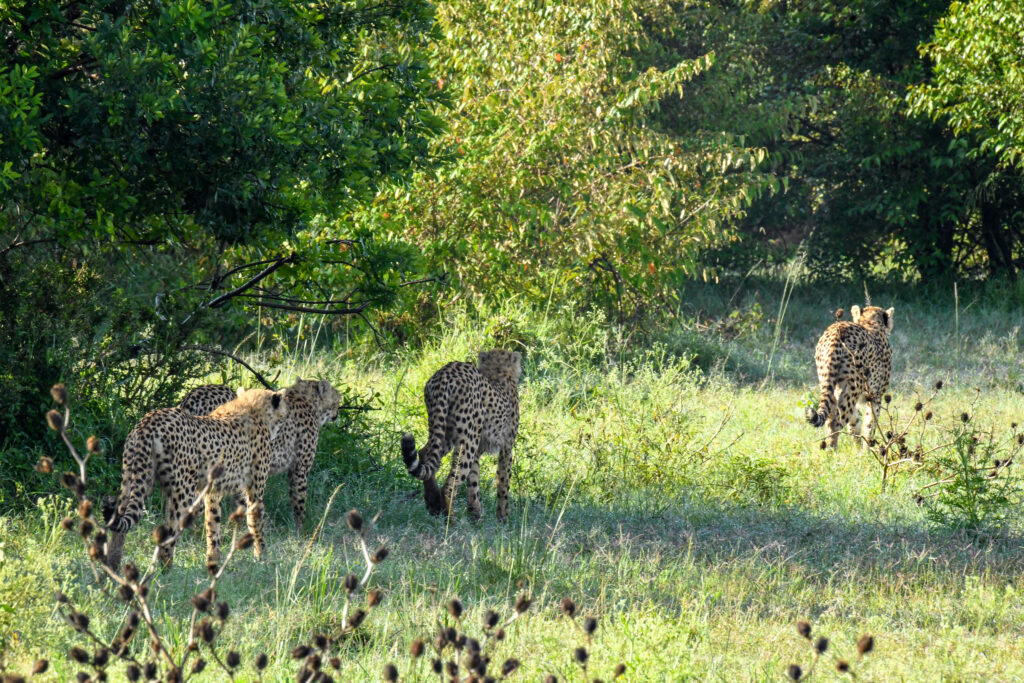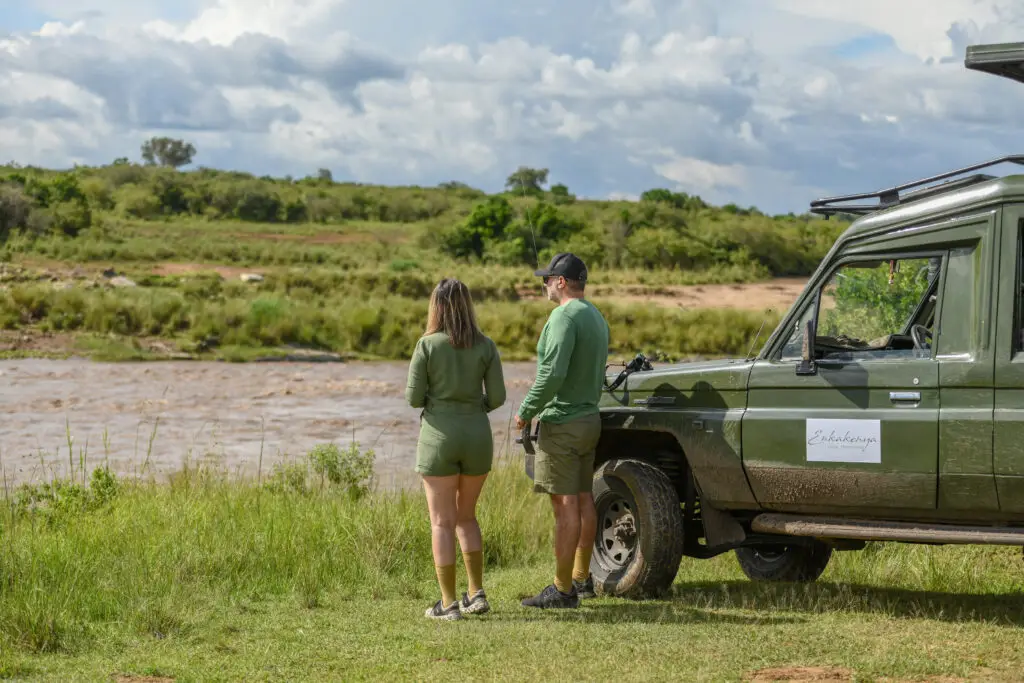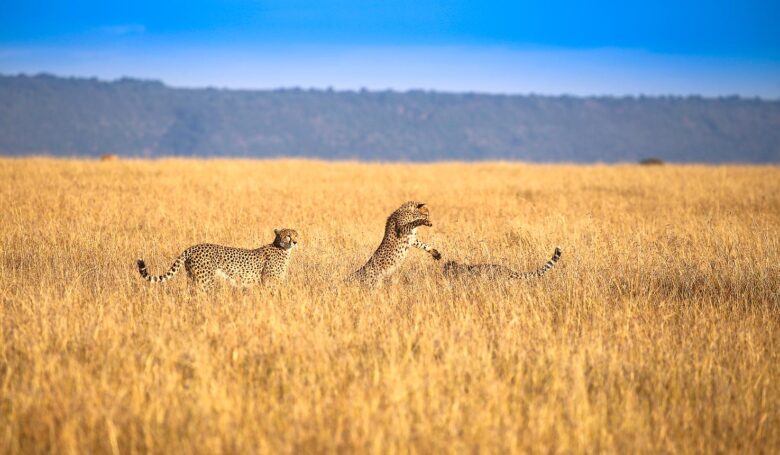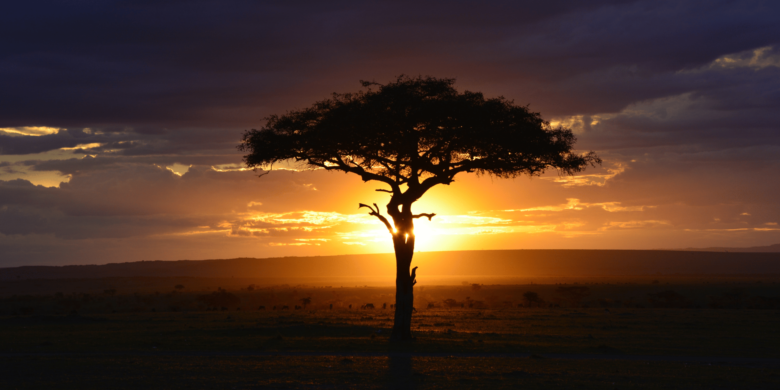The Green Season in the Masai Mara, also known as the Predator Season, vastly differs from the migration and river crossings for which the Masai Mara is renowned. On our safari dates, you will see the most beautiful green landscapes with short grass that sometimes resembles a lawn, sunsets and sunrises that burst with orange, and the most fantastic cloud formations.
This is also prime time for several plains game births, such as zebra, topi, wildebeest, hartebeest, and gazelle, which are an obvious choice for the cats that have to feed their cubs and pups. The elephants and giraffes on the plains of the Masai Mara will provide you with some of the best photographic opportunities for landscapes, close-ups, and silhouette shots. Also not to be overlooked are the hippos and the gigantic crocodiles in the rivers. For bird photographers, expect to see crowned cranes, ground hornbills, rollers, bee-eaters, the Kori bustard, and a host of smaller birds like the Jackson’s widowbird, etc.
What is the Green Season in the Maasai Mara?
The Green Season in the Maasai Mara runs from November to April, bringing increased rainfall that transforms the savannah into a lush paradise. This vibrant landscape offers unique opportunities for wildlife encounters and a quieter safari experience.
The Maasai Mara is home to the highest concentration of big cats, especially lions and cheetahs, making it a prime destination for wildlife photographers. Additionally, it hosts diverse wildlife, including leopards, serval cats, and hyenas, enhancing its appeal as a top safari location.

Why we recommend Kenya in the Green Season
- You generally have the parks and reserves to yourself.
- You’ll receive more personal attention from guides and camp staff.
- Places to stay are quieter with far fewer guests around.
- It’s a time of plenty for the animals and they take full advantage of the abundant food as well as giving birth to their young.
- Although the wildlife is a little harder to spot because the vegetation has grown, you shouldn’t have to wait too long before you see something new and you should still see all the animals you would normally see in the drier months.
- And, it’s cheaper.
What Makes a Green Season Safari Special?
Here are a few great reasons to plan your next safari for the “secret” season
You’ll enjoy fewer crowds and great exclusivity
Travelling during the green season can provide a unique and exclusive wildlife viewing experience. Visitors may find themselves as the only vehicle at a wildlife sighting, surrounded by the expansive landscapes of the Masai Mara or Serengeti without the presence of other tourists. This period is ideal for those seeking to avoid long queues at park gates and airports. While the southern Serengeti may attract more visitors due to the wildebeest calving season, most other regions offer exceptional wildlife observation opportunities in a more secluded setting.

There are baby animals everywhere
Many mammals give birth during the wet season because there is plenty of water, grass for grazing, and tall grass to hide from predators. A safari in the green season lets you see these young animals as they explore their surroundings. In November, watch for groups of warthog piglets running through the bush. In February, you can spot wild dog puppies coming out of their dens. By March, zebra foals take their first steps, and baby elephants learn to control their trunks.
The Green Season is a Birdwatchers Paradise
As many as 200 migratory bird species journey from various regions of the northern hemisphere to East Africa during the rainy season, transforming it into a haven for birdwatchers. The waterways in Nyerere and Ruaha national parks experience a significant rise in bird populations. Moreover, numerous birds will be flaunting their breeding colours—an awe-inspiring view even for those who are new to birdwatching.
The Great Calving Season
One of the most captivating sights during the Green Season is the calving season, which typically reaches its peak from January to February. During this time, numerous herbivores, such as wildebeests and zebras, give birth to their young in the lush, green pastures of the Mara. This period is critical for the dynamics between predators and prey, as lions, cheetahs, and hyenas capitalize on the vulnerability of the newborns. Witnessing the intense drama of predators and prey set against the vibrant backdrop of the Green Season offers a truly unparalleled safari experience.
Photographic Conditions are Ideal
Picture dramatic skies with dark storm clouds and bursts of light breaking through, the first rainfalls dispelling the dust of the dry season, and a landscape turning green with carpets of flowers. This stunning scenery makes the green season a photographer’s dream
Special Season Rates
Another advantage of travelling during the Green Season is the availability of special rates. Because it’s considered a “low season” in tourism, you can often enjoy more affordable rates for your stay, without compromising on quality or luxury. This makes it an excellent opportunity for those looking to enjoy a premium safari experience at a fraction of the cost.
Conclusion
The Green Season in the Maasai Mara is an exquisite hidden gem, offering a profoundly different safari experience, abundant with natural splendour, diverse wildlife, and serene landscapes. At Enkakenya Mara Camp, you will uncover the Maasai Mara in its most resplendent and tranquil form, where the tranquillity of fewer crowds allows for unparalleled, intimate wildlife encounters.
Should you be ready to immerse yourself in the lush, verdant beauty of the Maasai Mara, the Green Season awaits your arrival. Secure your stay at Enkakenya Mara Camp today, and prepare to craft memories that will last a lifetime.



